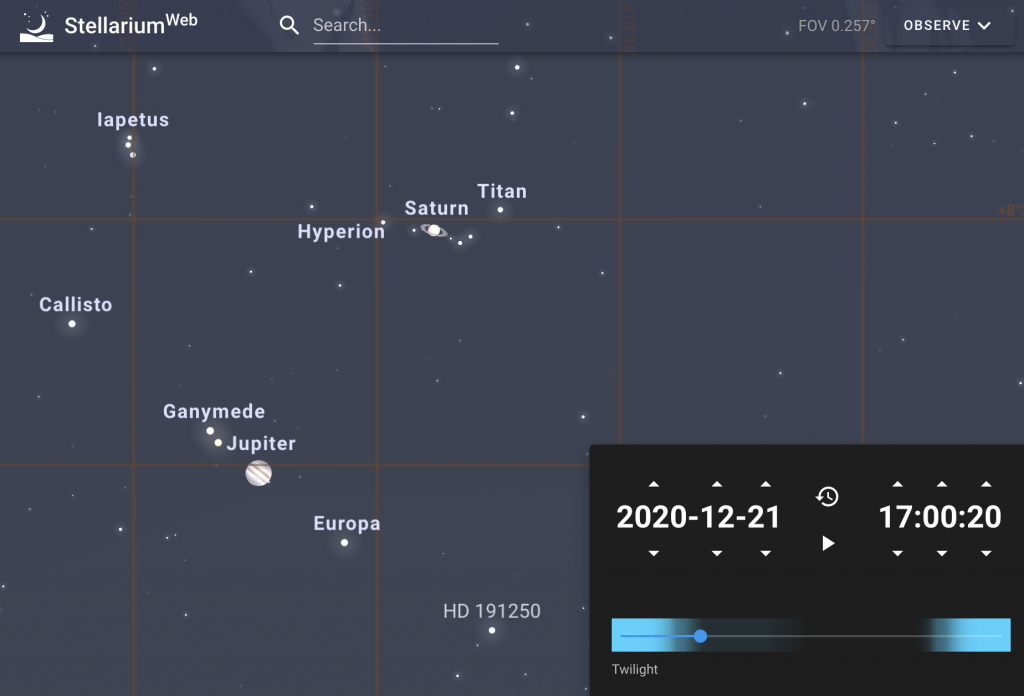A spectacular event is unfolding in the night skies this December, as Jupiter and Saturn appear closer in the sky than at any time in the past four centuries. Not to be missed!
Look towards the west on a clear December night, just after sunset, and it will be hard to miss the sight of two bright planets moving ever closer together. The gas giants Jupiter and Saturn are moving towards their conjunction on December 21st, when they’ll appear less than a tenth of a degree apart – just a fifth of a full-moon diameter. It’ll be the first Jupiter-Saturn conjunction since the year 2000 (when it happened too close to the Sun for us to see), the closest Jupiter-Saturn conjunction since 1623, and won’t be matched again until the Jupiter-Saturn conjunction of March 15, 2080!

As you gaze at these distant points of light, just remember that the photons of light entering your eyes have travelled across the Solar System from the Sun to be reflected by the alien clouds on these distant worlds – clouds of ammonia ice crystals, organised in the familiar banded patterns on each world. The light from distant Saturn is also reflected by the delicate rings. Those reflected photons then travel back across the Solar System, through our turbulent atmosphere, to finally meet the photoreceptors in the back of your eyes.
You can also think about the planetary science happening here at Leicester – researchers are involved in studying Jupiter’s atmosphere and magnetosphere via the NASA Juno mission, which has now been orbiting the giant planet since 2016. And Saturn’s atmosphere will still contain the vaporised remnants of the Cassini spacecraft, which orbited for 13 years from 2004-2017, and allowed Leicester scientists to be involved in the most comprehensive characterisation of a giant planet of all time.
Of course, Jupiter and Saturn aren’t really that close together – this is all a matter of perspective. Saturn remains almost twice as far from the Sun as Jupiter. Jupiter and Saturn are in conjunction every 19.85 Earth-years. Since Jupiter takes 11.86 years to orbit the Sun and Saturn takes 29.4 years, every 19.85 years they appear to pass each other in the night sky. This great conjunction is also of interest scientifically – Dr. Jon Nichols has been using the Hubble Space Telescope to observe Saturn’s auroras while Saturn passes through the long, extended tail of Jupiter’s magnetosphere – watch this space for the results of that programme!

From Leicester, sunset on December 21st will be at 15:51 GMT. According to InTheSky.org, the planets will become visible around 16:18 (GMT) as the dusk sky fades, 11° above our south-western horizon. They will then sink towards the horizon, setting 2 hours and 30 minutes after the Sun at 18:20. This is an excellent time for families and children to be amateur astronomers, without the need for the late night! Jupiter will be at mag -2.0; and Saturn will be at mag 0.5. Both objects will lie in the constellation Capricornus.
They will be close enough to fit within the field of view of a telescope, but will also be visible to the naked eye or through a pair of binoculars. Do take this opportunity to check out this spectacle, and visit http://jupitersaturn2020.org/ to find out more about this rare event. Also check out this great visualisation using Stellarium, prepared by Matthew Bate at the University of Exeter:
If you’re able to catch any photographs of this rare event, particularly with Leicester landmarks in the foreground, we’d be very excited to hear from you! Please send them along to phys.community@le.ac.uk.

 Subscribe to Physics & Astronomy's posts
Subscribe to Physics & Astronomy's posts
Recent Comments